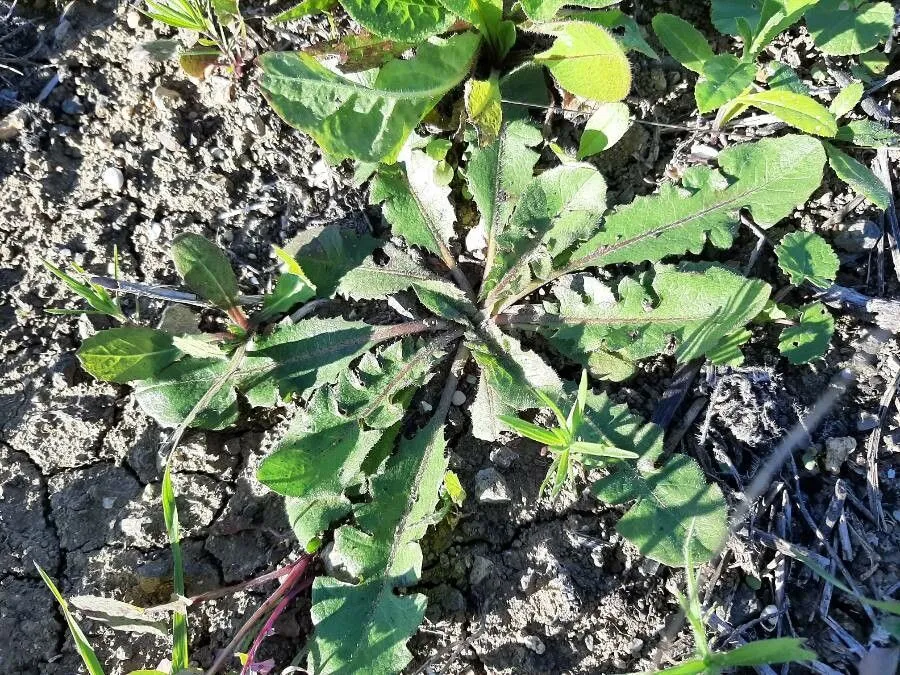
Author: L.
Bibliography: Sp. Pl.: 805 (1753)
Year: 1753
Status: accepted
Rank: species
Genus: Crepis
Vegetable: False
Observations: Medit.
Crepis vesicaria, commonly known as the Crepis-dandelion, is a noteworthy member of the Asteraceae family. The species was first described by Carl Linnaeus in 1753, appearing in his seminal work “Species Plantarum” on page 805. Hailing from the Mediterranean region, Crepis vesicaria exhibits the robust resilience and adaptability that is characteristic of flora from this diverse climatic zone.
This perennial herbaceous plant showcases a rosette of basal leaves, reminiscent of its close relative, the dandelion, though it can be distinguished by its unique morphological traits. The foliage is typically lance-shaped with toothed or lobed margins, exuding a slightly rough texture due to the presence of fine hairs. As the plant matures, it sends up erect, branching stems that support a series of bright yellow flower heads. Each flower head is composed of numerous strap-shaped florets, contributing to the plant’s striking visual appeal.
Crepis vesicaria thrives in a variety of habitats, from rocky hillsides and grasslands to disturbed soils along roadsides and fields. Its ability to spread and colonize different environments makes it an interesting subject of study for botanists and horticulturists alike.
The plant’s ecological role is significant as well; it provides nectar and pollen for various pollinators, including bees and butterflies. This not only supports local biodiversity but also plays a part in the broader ecological networks within its native range.
In terms of ethnobotanical uses, while not as commonly referenced as the dandelion, Crepis vesicaria has been noted in some traditional practices, particularly in Mediterranean cultures, for its potential medicinal properties.
The Crepis-dandelion continues to intrigue botanists and plant enthusiasts, offering a compelling blend of beauty, resilience, and ecological importance. Its presence in diverse habitats stands as a testament to the intricate balances of nature, where even seemingly modest plants carry profound significance.
Eng: beaked hawk’s-beard, beaked hawksbeard, beaked crepis, crepis-dandelion, dandelion crepis, dandelion hawk’s-beard, weedy hawk’s-beard, weedy hawksbeard
Deu: blasen-pippau, löwenzahnblättriger pippau
Fra: crépide à vésicules, crépide étoilée, crépis à vésicules, crépis étoilé
Ita: radicchiella vescicosa
Sqi: shmangë fshikëzore
Swe: blåsfibbla
Cym: gwalchlys gylfinhir, gwalchlys gylfinog
En: Crepis-dandelion, Dandelion crepis, Dandelion hawk’s-beard, Beaked crepis, Beaked hawk’s-beard, Weedy hawk’s-beard, Beaked hawksbeard, Weedy hawksbeard
Sq: Shmangë fshikëzore
Ar: سراغة منتفخة
Ca: Cap roig
Nl: Paardenbloemstreepzaad
Fi: Voikeltto
Fr: Crépide à vésicules, Crépide étoilée, Crépis à vésicules, Crépis étoilé, Barkhausie à feuilles de pissenlit
De: Blasen-Pippau, Löwenzahnblättriger Pippau
It: Radicchiella vescicosa
Sv: Blåsfibbla
Cy: Gwalchlys gylfinog, Gwalchlys Gylfinhir
Taken May 31, 2018 by Ricardo Aperador Rubio (cc-by-sa)
Taken May 9, 2019 by Dieter Wagner (cc-by-sa)
Taken May 9, 2019 by Dieter Wagner (cc-by-sa)
Taken May 9, 2019 by Dieter Wagner (cc-by-sa)
Taken May 9, 2019 by Dieter Wagner (cc-by-sa)
Taken Apr 30, 2017 by Yoan MARTIN (cc-by-sa)
Taken Apr 30, 2017 by Yoan MARTIN (cc-by-sa)
Taken Apr 30, 2017 by Yoan MARTIN (cc-by-sa)
Taken Jul 13, 2009 by EOL − Zoya Akulova (cc-by-nc)
Taken Oct 14, 2017 by Fejul Xeto (cc-by-sa)
Taken Apr 30, 2017 by Yoan MARTIN (cc-by-sa)
Taken Jan 5, 2022 by Fernando Cristovao (cc-by-sa)
Taken Mar 18, 2017 by Tela Botanica − Liliane ROUBAUDI (cc-by-sa)
Taken Mar 14, 2019 by Therese Therese (cc-by-sa)
Taken Oct 14, 2017 by Fejul Xeto (cc-by-sa)
© copyright of the Board of Trustees of the Royal Botanic Gardens, Kew.
© copyright of the Board of Trustees of the Royal Botanic Gardens, Kew.
© copyright of the Board of Trustees of the Royal Botanic Gardens, Kew.
Taken Jan 19, 2022 by Monteiro Henrique (cc-by-sa)
Taken Mar 13, 2022 by Manū (cc-by-sa)
Taken Apr 30, 2017 by Yoan MARTIN (cc-by-sa)
Taken Mar 27, 2021 by Prieta Javier (cc-by-sa)
Taken Mar 18, 2017 by Tela Botanica − Liliane ROUBAUDI (cc-by-sa)
Taken Apr 13, 2008 by Martin Bishop (cc-by-sa)
Taken Feb 18, 2022 by Lugifa Lugifa (cc-by-sa)
Taken Apr 30, 2017 by Yoan MARTIN (cc-by-sa)
Taken Nov 6, 2017 by Llandrich anna (cc-by-sa)
Taken Nov 11, 2015 by Tela Botanica − Thibaut SUISSE (cc-by-sa)
Taken May 17, 2022 by Bart van Ulden (cc-by-sa)
Taken Mar 29, 2022 by Sergio costantini (cc-by-sa)
Taken Mar 14, 2019 by Jean Burger (cc-by-sa)
Taken Mar 20, 2021 by mike (cc-by-sa)
Taken Apr 4, 2015 by Tela Botanica − Ans GORTER (cc-by-sa)
Growth habit: Forb/herb
Ph maximum: 7.5
Ph minimum: 7.0
Light: 8
Atmospheric humidity: 5
Bloom months: [‘may’, ‘jun’]
Soil nutriments: 6
Family: Myrtaceae Author: (F.Muell.) K.D.Hill & L.A.S.Johnson Bibliography: Telopea 6: 402 (1995) Year: 1995 Status:…
Family: Rubiaceae Author: Pierre ex A.Froehner Bibliography: Notizbl. Bot. Gart. Berlin-Dahlem 1: 237 (1897) Year:…
Family: Sapindaceae Author: Koidz. Bibliography: J. Coll. Sci. Imp. Univ. Tokyo 32(1): 38 (1911) Year:…
Family: Asteraceae Author: A.Gray Bibliography: Pacif. Railr. Rep.: 107 (1857) Year: 1857 Status: accepted Rank:…
Family: Fabaceae Author: Medik. Bibliography: Vorles. Churpfälz. Phys.-Ökon. Ges. 2: 398 (1787) Year: 1787 Status:…
Family: Aspleniaceae Author: (Cav.) Alston Bibliography: Bull. Misc. Inform. Kew 1932: 309 (1932) Year: 1932…